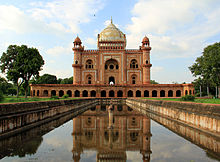This article needs additional citations for verification .(June 2021) |
| |||
|---|---|---|---|
| Buildings and structures +... |
The year 1754 in architecture involved some significant events.
Contents


This article needs additional citations for verification .(June 2021) |
| |||
|---|---|---|---|
| Buildings and structures +... |
The year 1754 in architecture involved some significant events.



Rococo, less commonly Roccoco, also known as Late Baroque, is an exceptionally ornamental and dramatic style of architecture, art and decoration which combines asymmetry, scrolling curves, gilding, white and pastel colours, sculpted moulding, and trompe-l'œil frescoes to create surprise and the illusion of motion and drama. It is often described as the final expression of the Baroque movement.

Baroque architecture is a highly decorative and theatrical style which appeared in Italy in the early 17th century and gradually spread across Europe. It was originally introduced by the Catholic Church, particularly by the Jesuits, as a means to combat the Reformation and the Protestant church with a new architecture that inspired surprise and awe. It reached its peak in the High Baroque (1625–1675), when it was used in churches and palaces in Italy, Spain, Portugal, France, Bavaria and Austria. In the Late Baroque period (1675–1750), it reached as far as Russia, the Ottoman Empire and the Spanish and Portuguese colonies in Latin America. In about 1730, an even more elaborately decorative variant called Rococo appeared and flourished in Central Europe.
The year 1752 in architecture involved some significant events.
The year 1858 in architecture involved some significant events.
The year 1864 in architecture involved some significant architectural events and new buildings.
The year 1774 in architecture involved some significant events.
The year 1782 in architecture involved some significant events.

Count Nicodemus Tessin the Younger was a Swedish Baroque architect, city planner, and administrator.
The year 1700 in architecture involved some significant events.
The year 1771 in architecture involved some significant events.
The year 1827 in architecture involved some significant architectural events and new buildings.
The year 1730 in architecture involved some significant events.

Johann Michael Fischer was a German architect in the late Baroque period.
The year 1744 in architecture involved some significant events.
The year 1756 in architecture involved some significant events.

Carlo Bartolomeo Rastrelli was an Italian sculptor and architect. Born in Italy, he moved in 1716 to Russia, where he worked until his death. His most famous works include the Monument to Peter I and a wax figure and several busts of Peter the Great. His son Francesco Bartolomeo Rastrelli became a prominent architect in Russia.

Elizabethan Baroque is a term for the Russian Baroque architectural style, developed during the reign of Elizabeth of Russia between 1741 and 1762. It is also called style Rocaille or Rococo style. The Italian architect Francesco Bartolomeo Rastrelli is the key figure of this trend, which is still given the name 'Rastrellian Baroque'. The Russian architect Savva Chevakinsky is also a renowned figure representing this style.